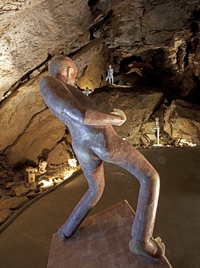Zbrašov Aragonite Caves - characteristics
HRANICE KARST
It represents a body of Early Paleozoic limestones that is several tens of square kilometers large and several hundreds of meters thick in the Maleník Massif in the surroundings of the town of Hranice. Its larger part is buried under layers of younger sediments and only individual limestone islets emerge on the surface. Its karstification, together with formation of caves and abysses, was caused by surface and atmospheric waters and was also significantly influenced by powerful springs of hot mineral water emerging along geological faults from great depths. Finally a unique thermal karst with the deepest abyss and the largest aragonite caves in the Czech Republic was created by these processes.
ZBRAŠOV ARAGONITE CAVES
-
They are situated under Zbrašov Hill in the left bank of the Bečva River in the spa of Teplice nad Bečvou.
-
They comprise a complicated complex of corridors, domes, chimneys and fissures at several height levels.
-
They are the only caves of hydrothermal origin in the Czech Republic.
-
They are decorated by unique karst fillings – “onyx” coatings on the walls, crystalline aggregates of aragonite and “geyser” stalagmites.

-
They contain “gas lakes” – spaces permanently filled with high concentrations of carbon dioxide.
-
They are the warmest caves in the Czech Republic – the underground air temperature is 14–16 °C, relative air humidity ca. 90 %.
-
They were discovered by the brothers Josef and Čeněk Chromý in 1912–13. After they dug the fissure with a seepage of warm air, they descended through a 42 m deep abyss to the underground area.
-
Their total length is 1,240 m with a difference in elevation (denivelation) of 55 m.
-
The guided tour route is 375 m long and the cave tour takes 60 minutes. In 2003 they were declared a national natural monument.
-
Since 1981, Mramorová síň (Marble Hall) has been used for concerts, theatre performances, weddings and, in particular, exhibitions of graphic works.).
Evolution of the Caves
STALACTITE, STALAGMITE AND MINERAL FILLINGS
Calcium carbonate (CaCO3), the raw material of calcite, crystallizes in three modifications:
- Calcite is the most common. Crystallizes in a trigonal system and forms crystals called rhombohedrons and scalenohedrons.
- Aragonite is a less common, high-temperature modification. It crystallizes in a rhombic system and generally forms needle-like crystals.
- Vaterite is a rare modification which crystallizes in a hexagonal system.
The temperature and chemical conditions of the Zbrašov Aragonite Caves and their mineral waters are sufficient for the formation of aragonite. In addition to needle-like aggregates, it also forms solid coatings in the caves.
Raft stalagmites are a phenomenon of the Zbrašov caves world. They have a characteristic conical shape and are up to several centimetres high. There is a hole in the top of the stalagmite and from the longitudinal cross-section it is apparent that the stalagmites “grew” in layers. Their central input channel cannot be proved with certainty, but their porous structure is quite distinct. There are two theories of their origin and growth. One of the theories supposes that they were formed by crystallization of calcium carbonate in places where mineral water sprung to the caves from the depths. The second one inclines towards the opinion that the stalagmites are so-called raft cones which developed on the bottom of cave lakes as accumulations of thin sinter crusts. They were primarily formed by evaporation of water on the lake surface (they were floating – therefore “rafts”). Then they were successively broken by dripping water and finally sank to the lake bottom. Their conical piles on lake bottoms were then strengthened by subsequent recrystallization. Raft stalagmites were already described in the caves around the world and the mentioned theory was applied to the Hranice Karst only when loose formations of similar shapes were discovered by divers in the depths of the Hranice Abyss.
Up to several decimetres thick coatings of the walls and ceilings together with round shapes of “doughnuts” are formed predominantly by calcite with admixture of iron oxides. These hydrothermal sinters were formed on the walls under the surface of the mineral water underground lakes.
Piquancies
Use of the caves beyond common cave operating hours:
-
At the end of World War II, Koblihová síň (Doughnut Hall) was used as a refuge for mothers and children from the village of Zbrašov.
-
In 1998, thermodynamic heating of the service building was installed; it takes water from the lake in the inaccessible area called Béčko (“B”).